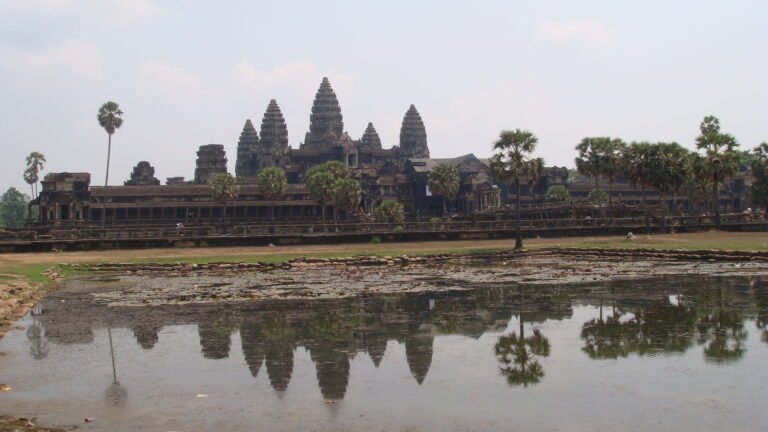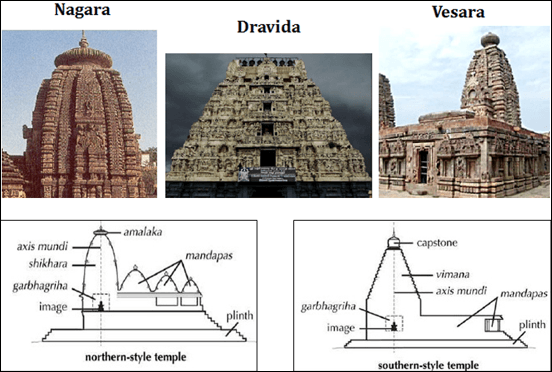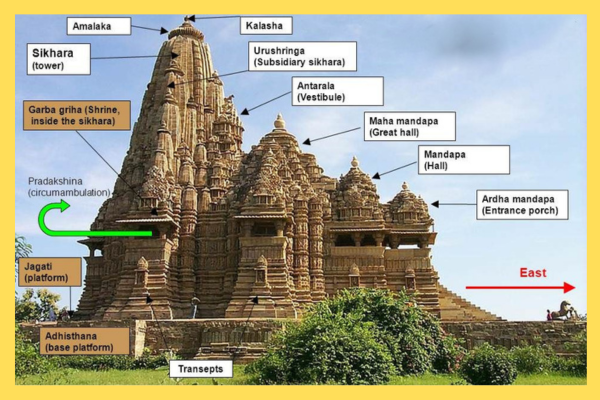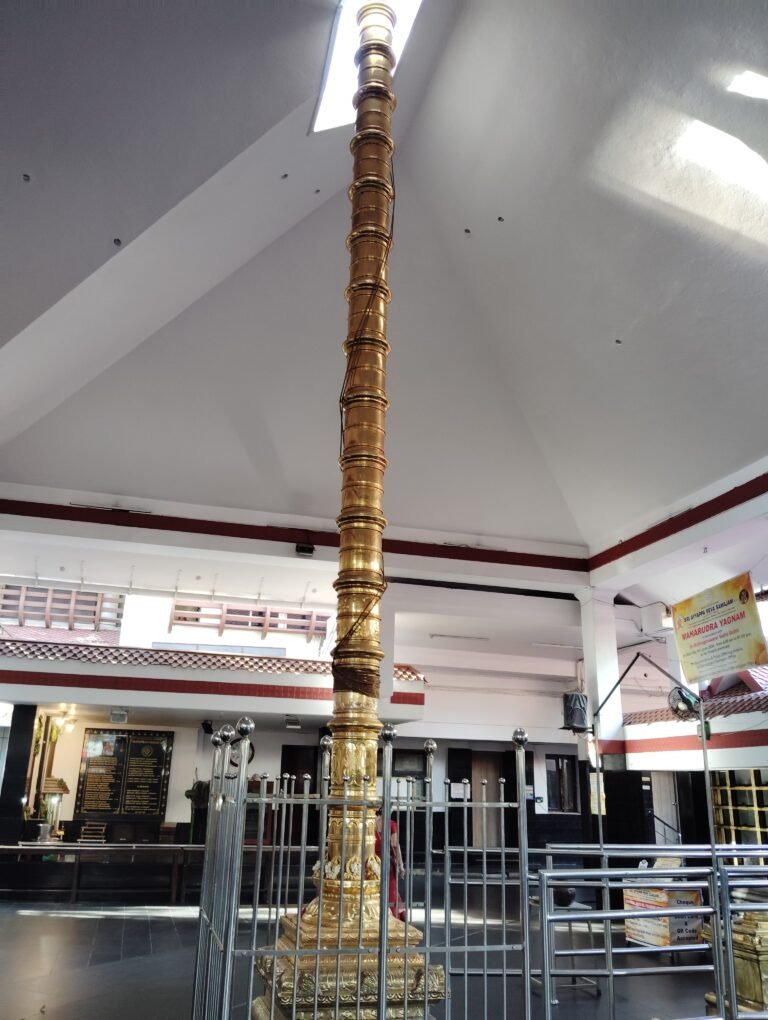Introduction:
India or Bharat is known as the land of Temples. The way of life of the follower of Sanatana Dharma has always been centered round the Hindu Temples and has a very deep significance. Apart from being known as a place of worship, Hindu Temples are also known for community gatherings, maintaining & showcasing its culture, imparting Vedic Knowledge & providing charity & food to the needy, to name a few. The temple is symbolically designed & constructed with sacred architecture which is primarily based on Hindu mythology, cosmology & metaphysical concepts. The main deity is housed in the sanctum sanctorum or “Vimana” or “Garbhagriha” with prayers & rituals being performed and offerings made, to invoke the deity and connect with the Divine.
There are many temples that are famously known as holy pilgrimage sites and it draws people from both near & far. Many of these sites involve long treks into the mountains. The symbolism here is to convey that a lot of physical & mental effort is initially required on this arduous spiritual journey. The devotee treads on this single pathway, with complete focus to achieve his objective of realizing the Supreme Brahman or Consciousness (<click here for more information on Brahman). This will then culminate with him getting the blessings of his Divine Lord as reward for all his efforts. Today this symbolism is lost as there are faster & more convenient means of transport available to reach these sacred sites. But there are many who also take the traditional route like their ancestors had done earlier.
Idol Worship:
Followers of Sanatana Dharma or Hinduism have often been called polytheistic, idolaters, heathen, pagan, non-believers & infidels etc. This is due to a misunderstanding that they worship numerous Gods & Goddesses in the form of stone Idols. The reality is that he prays to only ONE GOD in the form of an idol and not to the Idol alone. Secondly, the divinity of God in infused into the Idol during an energizing process called “Prana Prathishta”. Essentially, he worships “God as an Idol and not an Idol as God”. That one God is known as the “Supreme Brahman or Consciousness”. HE is the ONE in ALL. All the Gods & Goddesses are mere manifestations or depictions of this un-manifested Brahman.
But why is an Idol needed?
Our mind is constantly in the pursuit of material objects, monetary gains and involved in sensual gratification of whatever our terrestrial world has to offer. Therefore our mind always wanders and is in constant state of turmoil because of these “vasanas” or desires. Such a disorderly mind cannot concentrate! By the introduction of an Idol in name & form, we can withdraw our mind from the external world and bring it into a single point focus. This will eventually help us concentrate on the Supreme Self within. The mind thus brought into single point focus is eventually directed towards meditation and the final realization of the Supreme Self, which is indeed the ultimate goal! In fact, the word Religion is derived from the Latin word “Religare” (“Re” means “again & again or back” and “ligare” means “to bind”) or to bind back to God or origin, which as per Hinduism is the Supreme Self or Brahman – the SOURCE! This is exactly what Sanatana Dharma also conforms to, as explained above!
Hindu Temples have continued to exist over many thousands of centuries and they symbolize the perseverance of Sanatana Dharma’s devotees. There are two points to note here. 1) If the Temples were damaged or destroyed over time, they were built & re-built on the same energy space they once stood before, in order to maintain their sanctity. 2) Temple was not just a place of worship, as entire communities lived around the temple complex and contributed to the “Temple Ecosystem” (<click here if you require further details on the temple ecosystem). A classic example is the worlds’ largest Hindu temple complex Angkor Wat (<click here) where use of LIDAR (Light Detection & Ranging, which is a remote sensing method) has revealed that this temple had once been integrated into a large well-planned urban landscape together with other temple complexes, making it significantly bigger than what was previously thought! This confirms the two points made above.
Main types of Hindu Temples:
The three main types of Temples are as follows:
Nāgara Style: This style was prevalent from 200 BCE to 800 CE and have Beehive shaped towers with pointed apices and elaborately carved entrances. Usually these style is found in North India
Drāvida Style: Time Period of Drāvida style is from 600 CE to 1500 CE in southern India. They are typically have pyramid shaped towers known as gopurams with multiple levels. They are adorned with detailed carvings, depicting various mythological stories from the Puranas and other scriptures. Drāvida-style temples are found in South India and two famous examples are the Brihadeeswara Temple in Thanjavur and the Meenakshi Amman Temple in Madurai.
Vesara Style: Time Period of the Vesara style was from 700 CE and 1200 CE. This architecture is a hybrid of Nāgara & Drāvida styles combining both North & South Indian traditions. It has a curved tower like Nāgara but also features a pyramidal Vimana like Dravida. The Virupaksha Temple at Hampi and the Hazara Rama Temple of Deva Raya showcase this style.
A typical layout which provides the different segments of a temple is given below and most of us are familiar with it. The Garbhagriha or the Sanctum Sanctorum is where the Idol of the God is placed. Attached together with Garbhagriha are the Mandapas (sometimes consisting of all the three – Ardha Mandapa, Mandapa & Maha Mandapa). The Vimana is the pyramid structure built on the Garbhagriha of the temple. (The name Shikara is usually used to denote the top of the Vimana). On the top this Shikara is mounted Amalaka (ridged stone disk that supports the Kalasha found only in the Nāgara & Kalinga style temples) and upon which the Kalasha is mounted. Garbhagriha, Vimanas & Mandapas are therefore the main energy centers of the Temple. Apart from this we have the Gopuram, which is the entrance gateway to the Temple complex.
There are three forms of idol worship as per Agama Shastras. 1) Sakala which is morphic or having shape or form where the physical features are clearly visible. 2) Nishkala which is Amorphic or formless like the Shiva Lingam 3) Sakala-Nishkala which is a combination of form & formless; for example a face of Shiva sculpted on a lingam.
We will now look at all the subtle aspects with respect to symbolism, significance & science in a temple. There are many blogs & articles on Temple science & worship. So I will restrict my blog to a few key aspects of the main elements in a Temple which are as follows:
- Bali Peetham & Dwajasthambam.
- The power of Granite & why it is the preferred choice of material for an Idol.
- Sound & its importance with respect to Energy, Frequency & Vibration.
- The Significance of Water & Fire in a Temple.
- Invigorating the Five Senses.
1. Bali Peetham & Dwajasthambam:
Bali Peetham:
Bali Peetham has been thought of by some as a place where animals (Goat/Chicken etc.) are sacrificed. Perhaps this was the case among some section of people in earlier times. Symbolism has taken over as man evolved over ages. (For example: The Japanese worship Goddess Durga (known as Juntei Kannon) and make offerings to her of pomegranate juice instead of goat’s blood like it is done even today in some parts of India).
We will understand the significance & meaning of Bali Peetham first, with the help of a quote from Manusmriti. (Please note here that the Manusmriti text has been manipulated by many people to suit their vested interests. Therefore everything written in this text cannot be taken literally. In my blog on Jnana Mudra (<click here for more information), I have discussed the difference between Jñāna (Knowledge) & Vijñāna (Wisdom) & how to remove “Ignorance”. If we are to truly understand the essence of our scriptures, we need to go through the process of “Śravana” & “Manana” and then finally merge with the Supreme Self by practising “Nidhidhyāsana”).
अध्यापनं ब्रह्मयज्ञः पितृयज्ञस्तु तर्पणम् ।
होमो दैवो बलिर्भौतो नृयज्ञोऽतिथिपूजनम् ॥ ७० ॥
adhyāpanaṃ brahmayajñaḥ pitṛyajñastu tarpaṇam |
homo daivo balirbhauto nṛyajño’tithipūjanam || 70 ||
Manusmriti 3.70: Translation: Teaching is the sacrifice offered to Brahman or Brahma sacrifice, Tarpana or the offerings of water and food is the Pitri-sacrifice or sacrifice to the manes (ancestors), Homa or the oblation offered to the fire is the offering to Devas or Gods, Bali is the offering given to Bhutas (elements) and the hospitality to guests/people is the Manushya (Jana in Sanskrit) sacrifice.
Comments: A follower of Sanatana Dharma is advised to offer five sacrifices every day as stated below:
1) Sacrifice to Rishis or Scriptures: Vedas are attributed to various Rishis who complied them. Reading, studying & contemplation on the sacred scriptures, for acquiring knowledge and then in turn, teaching it to someone who does not possess that knowledge, is a form of sacrifice!
2) Sacrifice to Devas (Gods): This sacrifice is by means of Homa/Yajna to all the intelligent cosmic beings or Devas in Nature/Universe. We then realize that we need to be in harmony with beings of all the three worlds ie; Prithvi (Earth), Antarikṣa (Atmosphere that is above earth) & Dyau (Heavens or outer space).
3) Sacrifice to Pitris (Ancestors): Paying homage or Pitru Ţarpaņ to our older deceased generations or ancestors. By this we recognize the fact that we live in this world today because of them and acknowledge the debt we owe them. There are specific temples located near rivers, which are visited to offer Pitru Tarpan to the deceased relatives.
4) Sacrifices to People/Men: This sacrifice pertains to helping the poor & the needy. Understanding that our duty includes serving the humanity.
5) Sacrifices to Bhutas: Placing food before beginning of our meal, for the Bhutas who are the lower entities or animals around us. This is to acknowledge & care for beings who are lesser in the food chain than us.
Bali means sacrifice and Peetham is the Pedestal and therefore it is known as the “Sacrificial Pedestal”. Respects are paid both by the Priests & Devotees as they pause by this pedestal during the process of worship.
- Sacrifice by Devotees: A man’s Ego (Ahamkāra) is caused by his Ignorance (Ajnanam). Aham is “I” and Kara is “to do or act” meaning – I am the doer of everything which creates our identity. Every human is born with Ego. It is unavoidable. Ignorance is because of not knowing our true nature which is beyond the body, mind & senses. The Bali Peetham is the first element of the temple where a devotee pauses to sacrifice (let go) of his Ego, as it is the Ego that prevents him from understanding his true inner Self – Supreme Brahman. The devotees then shifts his focus to his Inner Self as he proceeds further into the temple, leaving his Ego behind.
- Sacrifice by Priests: The priests at the temple normally offer Prasad (any cooked food or boiled rice) together with flowers at the Bali Peetam. Therefore, Bali Peetham is also called the “Seat of Offerings”. This is usually done after offering the Prasad to the Main Lord and other deities of the temple. It is believed that the food offered at this place would be accepted by the deities and the other elementary forces (lower entities around us).
In essence, any person who has realized his true SELF does not get influenced by his Ego, as he knows that Ego causes delusion. The Ego of such a “realized person” is compared to that of a burnt rope – the shape remains, but the rope has lost its power to bind.
Dwajasthambam:
After the Bali Peetham, one can see the Dwajasthambam (<click here for more information) which essentially means Flag Pole (Dwaja meaning “Flag” and Stahmbam means “Pole”) and this is made as per preparation, rituals & installation of Agama Shastra. Sometimes the Bali Peetham is placed after the Dwajastahmbam and the devotee prostrates by the side of whichever comes first. If we take Brihadeeshwara Temple as an example, the Dwajasthambam pole is made of flawless Burma Teak and both the base & pillar covered with copper sheets. It has 32 rings at base signifying the 32 rings of human spinal cord.
It also serves as a lighting arrestor, being one of the two the highest points in the temple complex, the other is the Kalasa on top of the Vimana or Garbhagriha. Flags are raised at top of the pole indicating the start of temple festivities and also to showcase the symbol of the Vahana or Vehicle of the presiding deity of the temple (Example: Nandi for Lord Shiva). These are the two main purposes of the Dwajasthambam.
The main “energy points” in a Temple are the Garbhagriha/Vimana, Mandapas and Idols of Deities. The idols are re-energized every 12 years during the process called Kumbhabhishekam or Jirnoddharam which is consecration of deity. The person carrying out this energizing process is usually an evolved or enlightened person. But do such men exist in today’s world who can infuse divine life into an idol?
In my next two blogs we will discuss interesting aspects of the power of Granite, Sound with respect to Energy, Frequency & Vibration, the significance of Fire & Water & how our five senses are invigorated in a temple.




